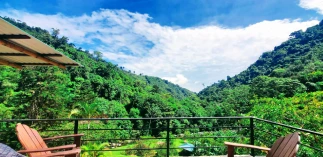Welcome back to the nature log of your Costa Rican retreat! Today, we’re turning our ears towards the trees in search of a boisterous resident, the Band-backed Wren.
This little songbird might be small, but its presence is anything but. Often found in groups of 4 to 12, the Band-backed Wren is a social butterfly (or should we say, wren?) of the forest canopy.
Spotting a Band-backed Wren
While these wrens aren’t shy, they can be tricky to spot thanks to their preferred hangout. Look up! Band-backed Wrens tend to stay mid-level to high up in the trees, flitting amongst the branches of tall pines, oaks, and evergreens. Their rich brown backs with bold black and white barring make them stand out if you know where to look.
Here’s a tip: listen for their call. The Band-backed Wren has a distinctive, short, and raspy “zek” call that can help you pinpoint their location. Their song is equally characterful, a delightful mix of dry chatters, splutters, and gurgles.
A Busy Body with a Big Appetite
The Band-backed Wren is a tireless forager. Their little legs propel them acrobatically as they explore the branches, poking into every nook and cranny in search of a tasty snack. They’re insectivores at heart, feasting on a smorgasbord of insects, spiders, and other invertebrates.
Watching a group of Band-backed Wrens work together is a sight to behold. Their constant movement and synchronized foraging make them seem like a well-oiled machine, ensuring no insect goes undetected!
A Family Affair
The Band-backed Wren is all about family. These birds are resident breeders, meaning they stay put year-round and raise their young in the lush Costa Rican mountains. Their nests are intricate woven structures of twigs and leaves, often tucked away in a hidden hollow or cavity within a tree.
Here at the retreat, we’re lucky enough to witness these family groups flitting through the trees. The adults, with their striking brown, black, and white plumage, are easily distinguished from the younger birds. Juveniles are a much duller affair, sporting a brown upper body and a buff to off-white underside.
A Sign of a Healthy Forest
The Band-backed Wren’s presence is a good indicator of a healthy ecosystem. These birds thrive in mature forests with a good variety of trees and undergrowth. So, the next time you hear their energetic calls or spot a flash of brown and white high in the canopy, take it as a sign that the Costa Rican wilderness around your retreat is flourishing!
For more information, please view our comprehensive guide about the birds of Costa Rica







